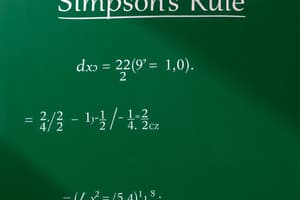Podcast
Questions and Answers
In Simpson's 1/3 rule, into what is the interval [a, b] divided?
In Simpson's 1/3 rule, into what is the interval [a, b] divided?
- An odd number of equal length subintervals
- An even number of equal length subintervals (correct)
- An odd number of subintervals of varying length
- An even number of subintervals of varying length
What is approximated by the area of a parabola in Simpson's method?
What is approximated by the area of a parabola in Simpson's method?
- The arc length of a curve
- The volume under a surface
- The slope of a tangent line
- The area under a curve (correct)
In complex analysis, what does i represent?
In complex analysis, what does i represent?
- Zero
- The square root of -1 (correct)
- A real number
- The square root of 1
For a complex number z = x + iy, where x and y are real numbers, what does |z| represent?
For a complex number z = x + iy, where x and y are real numbers, what does |z| represent?
According to Euler's formula, what is $re^{iθ}$ equivalent to?
According to Euler's formula, what is $re^{iθ}$ equivalent to?
What is the principal argument of z, denoted as Arg(z)?
What is the principal argument of z, denoted as Arg(z)?
What does the equation |z - z₀| = ρ represent geometrically?
What does the equation |z - z₀| = ρ represent geometrically?
What is a complex function?
What is a complex function?
If z = x + iy, what is its complex conjugate denoted as?
If z = x + iy, what is its complex conjugate denoted as?
What condition must be met for the limit of a function f(z) to exist as z approaches z₀?
What condition must be met for the limit of a function f(z) to exist as z approaches z₀?
If the limit of a function f(z) exists as z approaches z₀, what can be said about the limit?
If the limit of a function f(z) exists as z approaches z₀, what can be said about the limit?
Under what condition is a complex function f(z) considered continuous at a point z = z₀?
Under what condition is a complex function f(z) considered continuous at a point z = z₀?
When is a function f(z) said to be 'differentiable' at a point?
When is a function f(z) said to be 'differentiable' at a point?
What is a necessary condition for a function f(z) = u(x, y) + iv(x, y) to be analytic?
What is a necessary condition for a function f(z) = u(x, y) + iv(x, y) to be analytic?
What are the Cauchy-Riemann equations?
What are the Cauchy-Riemann equations?
If a function f(z) is analytic in a domain, what can be said about its differentiability?
If a function f(z) is analytic in a domain, what can be said about its differentiability?
What is an entire function?
What is an entire function?
In the context of complex numbers, what is a 'closed circular disk' defined by?
In the context of complex numbers, what is a 'closed circular disk' defined by?
What is the key characteristic of a 'connected set'?
What is the key characteristic of a 'connected set'?
In numerical integration, what is the purpose of methods like Simpson's rule?
In numerical integration, what is the purpose of methods like Simpson's rule?
In Simpson's 1/3 rule, what degree of polynomial is used to approximate the function?
In Simpson's 1/3 rule, what degree of polynomial is used to approximate the function?
What type of subintervals are needed for Simpson's 1/3 rule?
What type of subintervals are needed for Simpson's 1/3 rule?
Suppose you are using Simpson's 1/3 rule. If you divide the interal [a, b] such the h=(b-a)/n, what do you know about 'n'?
Suppose you are using Simpson's 1/3 rule. If you divide the interal [a, b] such the h=(b-a)/n, what do you know about 'n'?
Suppose f(z) = u(x, y) + i v(x, y) is a complex function. If it is differentiable, which equations must it satisfy?
Suppose f(z) = u(x, y) + i v(x, y) is a complex function. If it is differentiable, which equations must it satisfy?
Flashcards
Simpson's 1/3 Rule
Simpson's 1/3 Rule
Simpson's 1/3 rule divides an interval [a, b] into an even number of equal-length subintervals to approximate the definite integral.
Area Approximation
Area Approximation
In Simpson's rule, the area under a curve y = f(x) is approximated by using the area of a parabola passing through points on the curve.
Complex Number
Complex Number
Complex numbers have both a real and imaginary part, expressed as z = x + iy, where x and y are real numbers and i is the imaginary unit (√-1).
Absolute Value of Complex Number
Absolute Value of Complex Number
Signup and view all the flashcards
Polar Form of Complex Number
Polar Form of Complex Number
Signup and view all the flashcards
Euler's Formula
Euler's Formula
Signup and view all the flashcards
Principal Argument
Principal Argument
Signup and view all the flashcards
Complex Function
Complex Function
Signup and view all the flashcards
Complex Conjugate
Complex Conjugate
Signup and view all the flashcards
Limit of a Complex Function
Limit of a Complex Function
Signup and view all the flashcards
Continuity
Continuity
Signup and view all the flashcards
Complex Derivative
Complex Derivative
Signup and view all the flashcards
Differentiability
Differentiability
Signup and view all the flashcards
Analytic Function in D
Analytic Function in D
Signup and view all the flashcards
Entire Function
Entire Function
Signup and view all the flashcards
Cauchy-Riemann Equations
Cauchy-Riemann Equations
Signup and view all the flashcards
Study Notes
- Simpson's 1/3 rule is a method for approximating the definite integral of a function.
- The interval [a, b] is divided into an even number of equal-length subintervals.
- n must be even for this method to work.
- In this method, the area under the curve y = f(x) in the intervals [x₀, x₂] and [x₁, x₃] is approximated by the area of a parabola (or polynomial of degree 2) passing through the points M₀ = (x₀, y₀), M₁ = (x₁, y₁), and M₂ = (x₂, y₂) which lie on the curve y = f(x).
Simpson's 1/3 Rule Formula Derivation
- We let y = p₂(x) = Ax² + Bx + C be the equation of the parabola.
- The integral from x₀ to x₂ of f(x) dx is approximated by the integral from x₀ to x₂ of p₂(x) dx.
- p₂(x) passes through the points M₀, M₁, and M₂ which leads to the equations:
- y₀ = Ax₀² + Bx₀ + C
- y₁ = Ax₁² + Bx₁ + C
- y₂ = Ax₂² + Bx₂ + C
- The integral from x₀ to x₂ of (Ax² + Bx + C) dx is equal to the following, where h = (x₂-x₀)/2:
- (h/3) * [2A(x₂² + x₂x₀ + x₀²) + 3B(x₂ + x₀) + 6C]
- y₀ + 4y₁ + y₂ = A(x₀² + 4x₁² + x₂²) + B(x₀ + 4x₁ + x₂) + 6C
- Simplifying and substituting relationships gives the Simpson's 1/3 rule formula:
- Integral from x₀ to x₂ of f(x) dx ≈ (h/3) * [y₀ + 4y₁ + y₂]
Composite Simpson's 1/3 Rule
- Applying Simpson's 1/3 rule to a series of subintervals yields the composite rule:
- Integral from a to b of f(x) dx ≈ (h/3) * [y₀ + 4(y₁ + y₃ + ... + yₙ₋₁) + 2(y₂ + y₄ + ... + yₙ₋₂) + yₙ].
- This is also known as Simpson's 1/3 rule.
- In the formula, yᵢ = f(xᵢ) for 0 ≤ i ≤ n.
Error Bounds in Trapezoidal Rule
- For n=1, the error is given by Error = integral from x₀ to x₀+h of f(x) dx - (h/2)(f(x₀) + f(x₀+h)).
- This simplifies to Error = -(h³/12)*f''(ξ) for some ξ ∈ (x₀, x₀+h).
- For any n ≥ 1, the error is Error = -(b-a)/12 * h² * f''(ξ) for some ξ ∈ (a, b).
- This is also equal to Error = -(b-a)³/12n² * f''(ξ).
- The integral from a to b of f(x) dx ≈ h/2 * [f(x₀) + f(xₙ) + 2(f(x₁) + ... + f(xₙ₋₁))].
- Also, the error is -(b-a)³/12n² * f''(ξ), for some ξ ∈ (a, b).
- If we let m* = min(f''(t)) for t in [a, b] and M* = max(f''(t)) for t in [a, b],
- K = -(b-a)³/12n² < 0.
- K * m* ≤ f''(ξ) ≤ K * M*
Error Bounds in Simpson's 1/3 Rule
- Assume f(x) is four times differentiable and f^(4)(x) exists on [a, b] and is continuous
- Then the error e in the Simpson's 1/3 formula is e = -(b - a)⁵ / (180n⁴) * f^(4)(ξ) for some ξ in (a, b).
- Let m* = min(f^(4)(ξ)) and M* = max(f^(4)(ξ)).
- Then -(b - a)⁵ / (180n⁴) * M* ≤ error ≤ -(b - a)⁵ / (180n⁴) * m*.
Studying That Suits You
Use AI to generate personalized quizzes and flashcards to suit your learning preferences.




